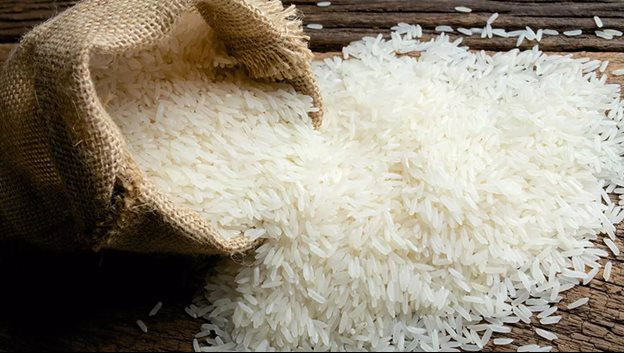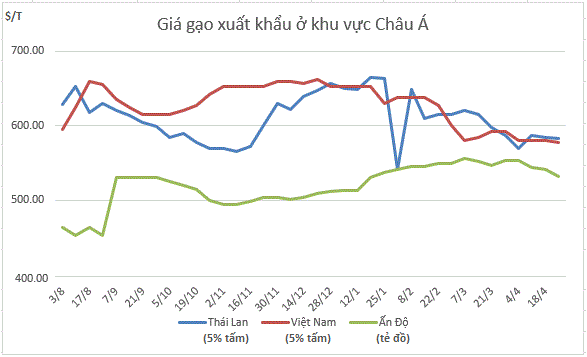
Global rice prices have now slipped below $600 per ton but could strengthen around June-July when the production and monsoon picture in Asia becomes clearer.
This will coincide with India’s upcoming election, when the country could relax its current export restrictions if buffer stock is comfortable.
India’s 5 per cent broken parboiled rice is quoted at $515-520 a tonne on a free on board (FOB) basis as demand weakened and Food Corporation of India has completed its domestic rice procurement.
Prices were also impacted as shipments of other rice varieties including parboiled and white were stuck after the country’s Customs intensified checks on consignments before clearance.
Prices Fall Below $ 600 a Tonne
According to the Thailand Rice Exporters Association, Indian parboiled rice is being quoted at $537-541 a tonne (C&F), compared to the Thai equivalent at $604 a tonne and Pakistan’s at $601-605 a tonne.
Thai white rice prices have also declined to $602 a tonne, while Pakistan and Vietnamese white rice is quoted at $575-585 a tonne. India has banned export of white rice since July 20, 2023, as part of efforts to cool domestic food grain prices that have been ruling high.

Asian export rice prices at multi-month lows.
As per the available data from Food Corporation of India (FCI), the procurement of paddy during Kharif marketing season touched 70.86 million tonnes (equivalent to 48 million tonnes of rice), while rabi procurement was 17.01 million tonnes (equivalent to 11.34 million tonnes of rice).
Price Dip is Temporary
India’s rice output in the 2024 kharif and rabi seasons is estimated at 123.83 million tonnes as against 125.51 million tonnes in 2022-23, according to India’s Ministry of Agriculture and Farmers Welfare. The Zaid (summer) crop, yet to be harvested, is expected to be close to 10 million tonnes.
“The current dip in global rice prices is temporary. Going forward, weather would dictate prices, based on acreage under the crop in India, Pakistan, Thailand, Vietnam and other nations such as Indonesia and the Philippines, and rainfall during the monsoon season,” said S Chandrasekaran, a New Delhi-based trade analyst.
Apart from weather, there are concerns about food security in the wake of geopolitical crises in the Gulf, the Taiwan region and Europe (Ukraine war).
With US elections due in November this year, countries like China may also try to stock up, which Chandrasekaran said would put pressure on the market.
Thai Production Dips
As long as India maintains the ban on white rice exports, the sentiment will remain positive for Thai rice prices in the first half of this year, Thailand’s Bangkok Post quoted Chookiat Ophaswongse, honorary president of Thai Rice Exporters Association, as saying. He expects rice prices to start improving from the second quarter itself.
Thailand’s rice output in 2023-24 is pegged at 19.9 million tonnes, down 5 per cent from 2022-23 due to lower water availability, according to the United States Department of Agriculture. Vietnam’s production is seen at 43.2 million tonnes as against 43.1 million tonnes in the previous year. However, both countries may have a lower carry-over stock from the previous season because of higher rice exports in 2023-24 due to India’s export restrictions.
The International Grains Council, in its latest rice market outlook report, said global rice production is estimated to decline marginally, while total consumption and stocks are also seen lower. However, 2024-25 could see an uptrend, though the pace of trade growth might be muted, with India likely to continue its export controls (export duty).
The Reason Behind India’s Export Curbs
“We are waiting for the Indian government to allow exports again,” said M Madan Prakash, President, All India Rice Exporters Association. “As of now, our operations have been restricted to just government-to-government export contracts.”
Chandrasekaran said countries such as Indonesia and the Philippines have also been aggressively sourcing rice in the global market, primarily from Vietnam and Thailand.
India initially banned export of broken rice in September 2022, when it also imposed a 20 per cent duty on exports of white rice. In July 2023, it banned the export of white rice and levied a 20 per cent duty on exports of parboiled rice besides fixing a minimum export price of $950 a tonne for basmati.
Since February 2024, Indian Customs officials, especially at Thoothukudi and Chennai ports, have tightened export scrutiny after complaints of under-invoicing, with white and parboiled rice being concealed under consignments of parboiled rice.
Despite the weather concerns, analysts said rice consuming nations, particularly in Africa, will have one factor to look forward to — the forecast of an approaching La Nina weather pattern, which brings more rains to Asia from July this year.
In 2023-24, paddy production suffered due to an El Nino weather pattern that set in around June 2023, causing dry weather across Asia, especially in India and Thailand.
Courtesy: Thehindubusinessline







































